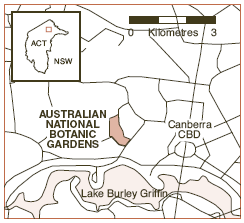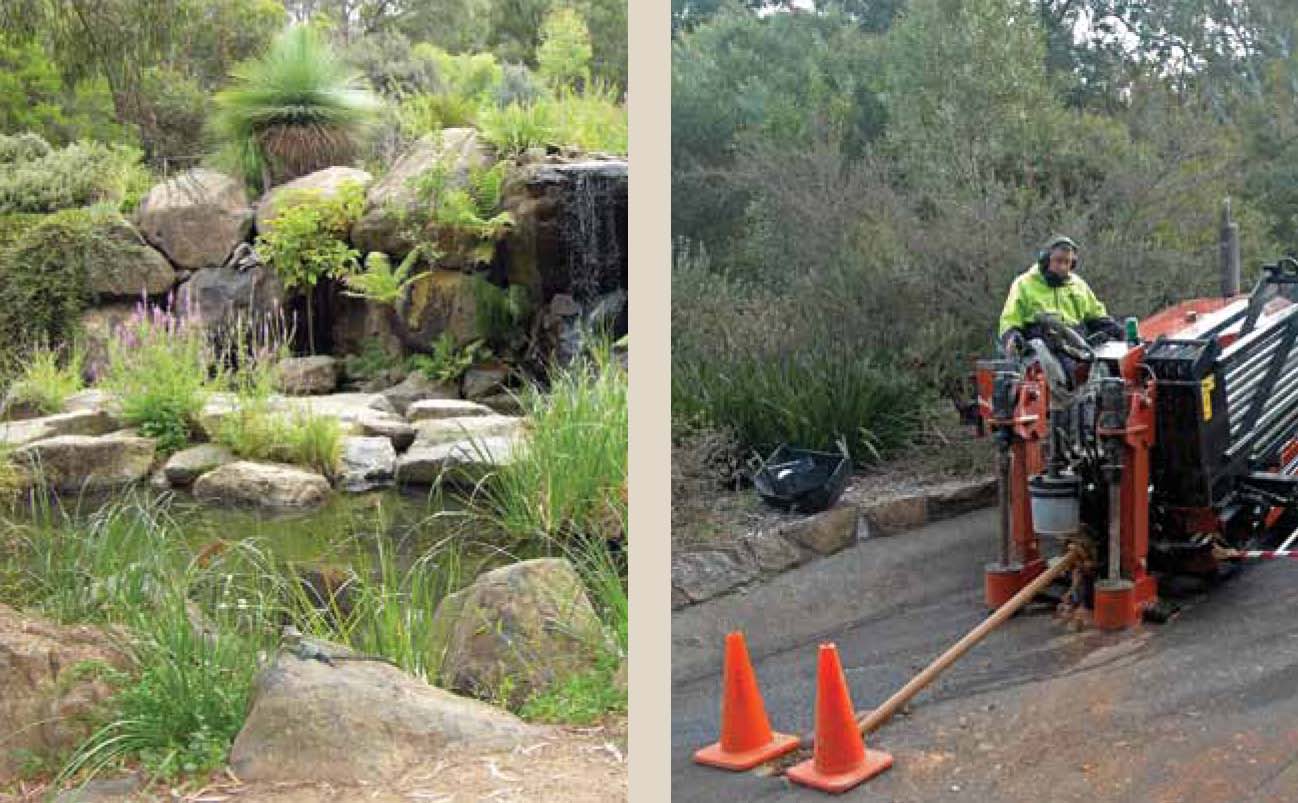![Director of National Parks [logo]](/images/dnp_90px.gif)


![Director of National Parks [logo]](/images/dnp_90px.gif) |
 |
 |
Extracted from the Director of National Parks Annual Report 2009 - 2010
http://www.anbg.gov.au
The Australian National Botanic Gardens (ANBG) is a major scientific, educational and recreational resource. It was one of the first botanic gardens in the world to adopt the study and display of a nation’s native species as a principal goal. Approximately one-third of the known flowering plant species that occur in Australia and about half the known eucalypt species are represented in its living collection. The ANBG is a national showcase for the horticultural use of Australia’s native plants. It is a partner in the Australian National Herbarium which provides the scientific identification of plant species represented in the living collection and scientific information on Australian plants.
The ANBG contributes to meeting Australia’s obligations
under international environment conventions to which Australia is a signatory. In particular, the Convention on Biological Diversity recognises the importance of botanic gardens in ex situ and in situ conservation, research, training, plant identification and monitoring, raising public awareness, providing access to genetic resources, and global cooperation in the sustainable use of plant biodiversity. The ANBG provides expert participation and contributes scientific data to the Global Biodiversity Information Facility and other international biodiversity projects.

| Location | Latitude 35°16’ South, Longitude 149°06’ East |
|---|---|
| Area | 85 hectares |
| Proclamation date | 17 September 1991 |
| IUCN category | Category IV |
| Biogeographic context | Displays plants from a diverse range of climatic and biogeographic regions—alpine to tropical, coastal to central desert |
| Management plan | Second management plan expired 9 January 2009. A draft third management plan is in preparation for release for public comment in 2010–11 |
| Other significant management documents | Risk Assessment and Management Schedule; ANBG Masterplan (National Capital Authority); ANBG Fire Procedures 2008; Agreement for the Establishment and Operation of the Centre for Plant Biodiversity Research (CPBR) between the Director of National Parks and the Commonwealth Scientific and Industrial Research Organisation (CSIRO); CPBR Strategic Plan |
| Financial | Operating | $9.652 million |
|---|---|---|
| Capital | $1.336 million | |
| Revenue | $10.448 million | |
| Visitors | 429,109 to site 107,498 to visitor centre | |
| Living plants | Planted in 2009–10: 4,000 Total number of taxa in the living collection: 6,077 Total number of registered plants in the living collection: 80,441 | |
| Herbarium specimens | Specimen records added to database in 2009–10: 11,119 Specimen records in database: 857,279 Total number of specimens in collection approximately 1.2 million: 899,265 items databased, plus approximately 300,000 not databased | |
| Australian Plant Name Index | Names added to APNI data base in 2009–10: 10,530 Total names in APNI database: 215,807 | |
| Australian Plant Census | Names added to APC database in 2009–10: 2,299 Total names in APC database: 19,431 | |
| Australian Plant Image Index | Images added in 2009–10: 6,481 Total number of images in collection: 63,315 | |
| Permits | 16 commercial activity permits; 39 wedding licences; 78 licences to publish 514 photographs from the collection; 4 research permits | |
| International conventions and agreements | |
|---|---|
| World Heritage Convention | Supports Australia’s World Heritage sites through botanical research, scientific plant collections, plant identification, botanical information management and horticultural and educational programs |
| Wetlands (Ramsar) Convention | Supports Australia’s obligations under the Ramsar Convention through access to plant identification services and data on aquatic plants in the Australian National Herbarium, and by delivering information on Australia’s aquatic plants through its website |
| Other agreements | Collaborates with international organisations including: • Botanic Gardens Conservation International • International Association of Plant Taxonomists • International Plant Propagators Society • International Union of Biological Sciences Taxonomic Databases Working Group • International Plant Name Index (Royal Botanic Gardens, Kew, and Harvard University) • Global Biodiversity Information Facility • International Organisation for Plant Information World Vascular Plant Checklist Project • Species 2000 • Millennium Seed Bank Project • American Public Gardens Association • Global Strategy for Plant Conservation |
| Environment Protection and Biodiversity Conservation Act 1999 | |
|---|---|
| Heritage | On Commonwealth Heritage List |
The ANBG is managed by an Executive Director supported by a General Manager, both appointed by the Director of National Parks. Since 1993 the ANBG has been a partner in the Centre for Plant Biodiversity Research, a joint research venture with CSIRO Plant Industry which incorporates the Australian National Herbarium. The herbarium retains voucher specimens for research and environmental studies and for plants at the ANBG.
ANBG staff stocktake the living collection and record information on plant locations, plant deaths and the overall health of the collection. This information is linked electronically to scientifically documented voucher specimens in the Australian National Herbarium. A team of botanists, including national and international collaborators, ensure that the correct botanical names are always applied to the ANBG’s living specimens and used in public interpretation. New accessions help to document the occurrence and distribution of plants in Australia.
Kangaroo, wallaby and rabbit populations are monitored to alert management to threats to the living collection. A venomous snake management plan monitors snake interactions with people.
Major challenges are:
Construction is well under way on an exciting new water project at the Australian National Botanic Gardens.
Since its inception, the Gardens has relied on a supply of Canberra’s normal drinking water for all its supply requirements including irrigation—the vast majority of its water use.
The changing climate, the recent years of drought, a focus on sustainability and the rising cost of drinking water led the Director of National Parks to commission a report investigating alternative water sources for the Gardens.
The report recommended that, subject to appropriate licensing, the most cost-effective and reliable supply of water for the Gardens was Canberra’s Lake Burley Griffin.
In 2007, the Gardens applied for a water allocation licence to extract 170 megalitres per year from the lake. The National Capital Authority granted a temporary licence to extract the water. In the future the ACT Government will look after the licensing agreement.
In 2009, the Australian Government provided $1.5 million through the Water for the Future plan to fund the water extraction project, including a new pipeline to the Gardens. The Director of National Parks committed a further $1.4 million to the project.
The Gardens engaged Engon Pty Ltd to develop specifications, engineering drawings and tender information for the construction phase. Gardens’ staff carried out the tender documentation and project management for the construction phase.
Construction began in April 2010, after the Gardens secured approvals from many ACT and Australian Government agencies. Draincorp Pty Ltd was the successful tenderer for this work.
The project is on schedule to be watering the living collection from non-drinking water by this summer. Using water from Lake Burley Griffin ensures long-term sustainability by reducing the Gardens’ operational costs and reliance on Canberra’s drinking water supply. The project is expected to free up around 170 megalitres of drinking water per year for other uses in Canberra.

A new pipe network to water Gardens’ plants with non-drinking water from Lake Burley Griffin will help provide a more sustainable future for the collections. Photos: ANBG
Director of National Parks | Annual Report 2009–10